
The Boidae, commonly known as boas or boids, are a family of nonvenomous snakes primarily found in the Americas, as well as Africa, Europe, Asia, and some Pacific islands. Boas include some of the world's largest snakes, with the green anaconda of South America being the heaviest and second-longest snake known; in general, adults are medium to large in size, with females usually larger than the males. Six subfamilies comprising 15 genera and 54 species are currently recognized.

Boa is a genus of non-venomous boas found in Mexico, the Caribbean, and Central and South America. Five extant species, and one extinct, are currently recognized.
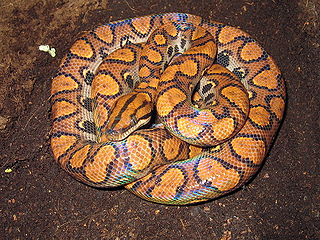
The rainbow boa is a boa species endemic to Central and South America. A semi-arboreal species, it is known for its attractive iridescent/holographic sheen caused by structural coloration. Five subspecies are currently recognized, including the nominate subspecies described here.

Corallus, the neotropical tree boas, are a genus of boas found in Central America, South America and the West Indies. Nine extant species are recognized as of 2017.
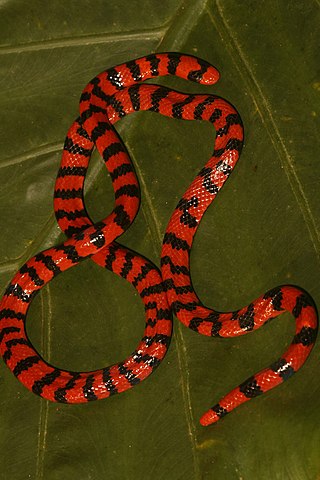
The Aniliidae are a monotypic family created for the monotypic genus Anilius that contains the single species Anilius scytale. Common names include the American pipe snake and false coral snake. It is found in South America. This snake possesses a vestigial pelvic girdle that is visible as a pair of cloacal spurs. It is ovoviviparous. It is non-venomous, and its diet consists mainly of amphibians and other reptiles. Two subspecies are recognized, including the nominate subspecies described here.

Loxocemus bicolor,the sole member of the monotypic family Loxocemidae, is a species of python-like snake found in Mexico and Central America. No subspecies are currently recognized. Analyses of DNA show that Loxocemus is most closely related to the true pythons and the sunbeam snakes.
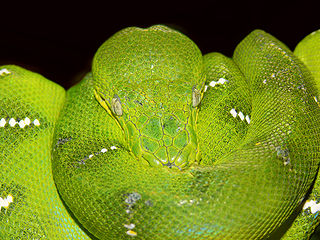
The emerald tree boa is a boa species found in the rainforests of South America. Since 2009 the species Corallus batesii has been distinguished from the emerald tree boa. Like all other boas, it is not venomous.

Corallus hortulana, commonly known as the Amazon tree boa, common tree boa, garden tree boa, and macabrel, is a boa species found in South America. No subspecies are currently recognized. Like all boas, it is non-venomous.
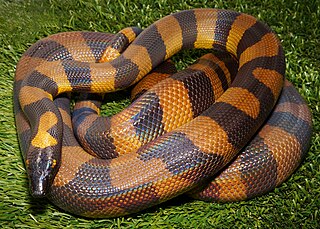
The Bismarck ringed python is a species of snake in the genus Bothrochilus found on the islands of the Bismarck Archipelago. No subspecies are recognized.

Bothriechis is a genus of venomous pit vipers, commonly called palm vipers or palm-pitvipers found predominantly in Mexico and Central America, although the most common species, B. schlegelii, ranges as far south as Colombia and Peru. All members are relatively slender and arboreal. The name Bothriechis is derived from the Greek words bothros and echis that mean "pit" and "viper" respectively. Ten species and no subspecies are currently generally recognized.

The Boinae are a purported subfamily of boas found in Central and South America, as well as the West Indies. In the Integrated Taxonomic Information System (ITIS), Boinae is considered an invalid synonym of Boidae.

Ungaliophis is a genus of dwarf boas found from southern Mexico to Colombia. Currently, two species are recognized.

Corallus grenadensis, also known as the Grenada tree boa or Grenada Bank tree boa, is a boa species found in Grenada. No subspecies are currently recognized. Like all other boas, it is not venomous.

Corallus cropanii, or Cropani's tree boa, is a species of boa, a snake in the family Boidae. The species is endemic to the state of São Paulo, Brazil. Like all boas, it is not venomous. No subspecies are currently recognized. Until 2017, no specimen of this snake had been seen alive since 1953 and only five dead specimens had been collected since then, but in late January 2017, an adult female Cropan's tree boa measuring 1.7 m was captured by locals in Ribeira who brought it to herpetologists from the Instituto Butantan and the Museum of Zoology of the University of São Paulo, who radio-tagged and released the animal to learn more about the species' behavior.

Corallus cookii, also known as Cook's tree boa or Cooke's tree boa, is a species of nonvenomous snake in the family Boidae. The species is endemic to the island of St. Vincent in the Caribbean. There are no recognized subspecies.

Corallus ruschenbergerii, commonly known as the Central American tree boa, common tree boa, and Trinidad tree boa, is a boa species found in lower Central America and northern South America. No subspecies are currently recognized. Like all boas, it is not venomous.

Corallus blombergi, the Ecuadorian annulated tree boa, is a boa species found in Pacific Ecuador.
Atropoides picadoi, also known as Picado's jumping pitviper, is a species of venomous snake, a pitviper in the subfamily Crotalinae of the family Viperidae. The species is endemic to Central America. There are no subspecies that are recognised as being valid. It is monotypic in the genus Atropoides.
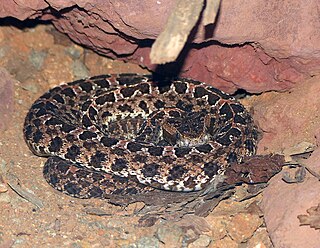
Porthidium ophryomegas is a venomous pitviper species found in Central America. No subspecies are currently recognized.

















